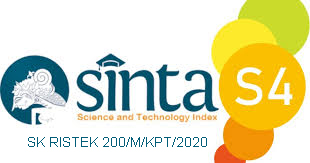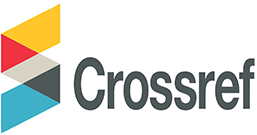Grouping of Village Status in West Java Province Using the Manhattan, Euclidean and Chebyshev Methods on the K-Mean Algorithm
Abstract
Keywords
Full Text:
PDFReferences
Al-roby, M. F., & El-halees, A. M. (2013). Classifying Multi-Class Imbalance Data. 37(5), 74–81.
Amandeep Kaur Mann, N. K. (2013). Review Paper on Clustering Techniques. Global Journal of Computer Science and Technology.
Awasthi, R., Tiwari, A. K., & Pathak, S. (2013). Empirical Evaluation On K Means Clustering With Effect Of Distance Functions For Bank Dataset. International Journal of Innovative Technology and Research, 1(3), 233–235.
Mishra, B. K., Rath, A., Nayak, N. R., & Swain, S. (2012). Far efficient K-means clustering algorithm. ACM International Conference Proceeding Series. https://doi.org/10.1145/2345396.2345414
Chakraborty, S., Nagwani, N. K., & Dey, L. (2011). Performance Comparison of Incremental K-means and Incremental DBSCAN Algorithms. International Journal of Computer Applications. https://doi.org/10.5120/3346-4611
Chaudhari, B., & Parikh, M. (2012). A Comparative Study of Clustering Algorithms using Weka Tools. International Journal of Application or Innovation in Engineering and Management (IJAIEM).
Claypo, N., & Jaiyen, S. (2015). Opinion mining for Thai restaurant reviews using K-Means clustering and MRF feature selection. 2015 7th International Conference on Knowledge and Smart Technology (KST), 105–108. https://doi.org/10.1109/KST.2015.7051469
Deepa, V. K., Rexy, J., & Geetha, R. (2013). Rapid development of applications in data mining. 2013 International Conference on Green High Performance Computing, ICGHPC 2013. https://doi.org/10.1109/ICGHPC.2013.6533916
Ding, S., Wu, F., Qian, J., Jia, H., & Jin, F. (2015). Research on data stream clustering algorithms. Artificial Intelligence Review. https://doi.org/10.1007/s10462-013-9398-7
Direktorat Jenderal Pemerintahan Umum, K. D. N. (n.d.). https://www.bps.go.id/statictable/2014/09/05/1366/luas-daerah-dan-jumlah-pulau-menurut-provinsi-2002-2016.html.
Gandhi, G., & Srivastava, R. (2014). Review Paper: A Comparative Study on Partitioning Techniques of Clustering Algorithms. International Journal of Computer Applications, 87(9), 10–13. https://doi.org/10.5120/15235-3770
Ghosh, S., & Kumar, S. (2013). Comparative Analysis of K-Means and Fuzzy C-Means Algorithms. International Journal of Advanced Computer Science and Applications. https://doi.org/10.14569/ijacsa.2013.040406
Grabusts, P. (2011). The choice of metrics for clustering algorithms. Vide. Tehnologija. Resursi - Environment, Technology, Resources. https://doi.org/10.17770/etr2011vol2.973
Harahap, F. R. (2013). Dampak Urbanisasi Bagi Perkembangan Kota Di Indonesia. Society, 1(1), 35–45. https://doi.org/10.33019/society.v1i1.40
Kouser, K., & Sunita, S. (2013). A comparative study of K Means Algorithm by Different Distance Measures. International Journal of Innovative Research in Computer and Communication Engineering.
KumarSagar, H., & Sharma, V. (2014). Error Evaluation on K- Means and Hierarchical Clustering with Effect of Distance Functions for Iris Dataset. International Journal of Computer Applications. https://doi.org/10.5120/15066-3429
Pratap, S., Kushwah, S., Rawat, K., & Gupta, P. (2012). Analysis and Comparison of Efficient Techniques of Clustering Algorithms in Data Mining. 3, 109–113.
Singh, A., Yadav, A., & Rana, A. (2013). K-means with Three different Distance Metrics. International Journal of Computer Applications. https://doi.org/10.5120/11430-6785
Soleh, A. (2017). Strategi Pengembangan Potensi Desa. Jurnal Sungkai, 5(1), 35–52.
Verma, M., Srivastava, M., Chack, N., Diswar, A. K., & Gupta, N. (2012). A Comparative Study of Various Clustering Algorithms in Data Mining. International Journal of Engineering Research and Applications Www.Ijera.Com.
Xu, L., Jiang, C., Wang, J., Yuan, J., & Ren, Y. (2014). Information security in big data: Privacy and data mining. IEEE Access. https://doi.org/10.1109/ACCESS.2014.2362522
DOI: https://doi.org/10.31326/jisa.v5i1.1097
Refbacks
- There are currently no refbacks.
Copyright (c) 2022 Gatot Tri Pranoto, Wahyu Hadikristanto, Yoga Religia

This work is licensed under a Creative Commons Attribution-ShareAlike 4.0 International License.
JOURNAL IDENTITY
Journal Name: JISA (Jurnal Informatika dan Sains)
e-ISSN: 2614-8404, p-ISSN: 2776-3234
Publisher: Program Studi Teknik Informatika Universitas Trilogi
Publication Schedule: June and December
Language: Indonesia & English
APC: The Journal Charges Fees for Publishing
Indexing: EBSCO , DOAJ, Google Scholar, Arsip Relawan Jurnal Indonesia, Directory of Research Journals Indexing, Index Copernicus International, PKP Index, Science and Technology Index (SINTA, S4) , Garuda Index
OAI address: http://trilogi.ac.id/journal/ks/index.php/JISA/oai
Contact: jisa@trilogi.ac.id
Sponsored by: DOI – Digital Object Identifier Crossref, Universitas Trilogi
In Collaboration With: Indonesian Artificial Intelligent Ecosystem(IAIE), Relawan Jurnal Indonesia, Jurnal Teknologi dan Sistem Komputer (JTSiskom)
JISA (Jurnal Informatika dan Sains) is Published by Program Studi Teknik Informatika, Universitas Trilogi under Creative Commons Attribution-ShareAlike 4.0 International License.


















